|
|
|
Sort Order |
|
|
|
Items / Page
|
|
|
|
|
|
|
| Srl | Item |
| 1 |
ID:
127938
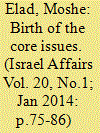

|
|
|
|
|
| Publication |
2014.
|
| Summary/Abstract |
In the last two decades, the Israeli-Palestinian conflict has been highly identified with the dispute over the core issues: Israel's annexation of East Jerusalem, the establishment of settlements in the disputed territories, the final borders between the two parties and the Palestinian refugee problem. The first three issues were a result of the 1967 war, while the refugee problem was a corollary of the 1948 war. However, it was the Israeli administration from 1967 to 1976 that exposed refugee camps to the Israeli public and made some initial efforts to resolve the problem.
|
|
|
|
|
|
|
|
|
|
|
|
|
|
|
|
| 2 |
ID:
116187
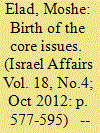

|
|
|
|
|
| Publication |
2012.
|
| Summary/Abstract |
In the past two decades the Israeli-Palestinian conflict has been identified with the dispute over four core issues: the future of East Jerusalem, the Jewish settlements in the disputed territories, the final borders between the two sides, and the fate of the Palestinian refugees. The first three issues were born during the first 10 years of Israel's control of the West Bank and East Jerusalem, while the refugee problem dates back to the 1948 war. Yet it was the Israeli administration from 1967 to 1976 that exposed the refugee camps to the Israeli public and led to initial efforts to resolve this problem. This first half of the two-part article outlines the establishment of the Israeli administration in the West Bank and East Jerusalem and lays the ground for the creation of the core issues which will be described in the second part.
|
|
|
|
|
|
|
|
|
|
|
|
|
|
|
|
| 3 |
ID:
149815
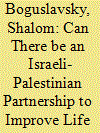

|
|
|
| 4 |
ID:
142440
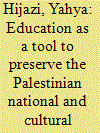

|
|
|
|
|
| Summary/Abstract |
How can Palestinian Jerusalemites empower educational institutions in East Jerusalem to ensure their right to education and maintain their national identity?
|
|
|
|
|
|
|
|
|
|
|
|
|
|
|
|
| 5 |
ID:
166887
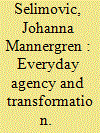

|
|
|
|
|
| Summary/Abstract |
How do we identify and understand transformative agency in the quotidian that is not contained in formal, or even informal structures? This article investigates the ordinary agency of Palestinian inhabitants in the violent context of the divided city of Jerusalem. Through a close reading of three ethnographic moments I identify creative micropractices of negotiating the separation barrier that slices through the city. To conduct this analytical work I propose a conceptual grid of place, body and story through which the everyday can be grasped, accessed and understood. ‘Place’ encompasses the understanding that the everyday is always located and grounded in materiality; ‘body’ takes into account the embodied experience of subjects moving through this place; and ‘story’ refers to the narrative work conducted by human beings in order to make sense of our place in the world. I argue that people can engage in actions that function both as coping mechanisms (and may even support the upholding of status quo), and as moments of formulating and enacting agential projects with a more or less intentional transformative purpose. This insight is key to understanding the generative capacity of everyday agency and its importance for the macropolitics of peace and conflict.
|
|
|
|
|
|
|
|
|
|
|
|
|
|
|
|
| 6 |
ID:
142449
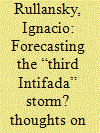

|
|
|
|
|
| Summary/Abstract |
History does not need to move forward lineally to a third or fourth or fifth intifada.
|
|
|
|
|
|
|
|
|
|
|
|
|
|
|
|
| 7 |
ID:
101426
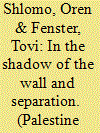

|
|
|
| 8 |
ID:
132330
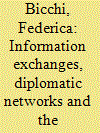

|
|
|
|
|
| Publication |
2014.
|
| Summary/Abstract |
This article analyses how, within the European Union foreign policy system, information is gathered and knowledge is constructed. The analysis is based on the evidence provided by a unique dataset, comprising the Heads of Mission reports between 1998 and 2010 and the EU member states' diplomatic networks. After distinguishing between information and knowledge, the article tackles three related aspects. First, it shows that the EU is able not only to favour information exchanges, but also to gather information and construct knowledge. Second, it argues that, while member states have an interest in contributing their own information and knowledge, European knowledge is also possible. This is demonstrated by means of an in-depth analysis of the preparation of the Heads of Mission report on East Jerusalem. Third, the article suggests that, depending on the reach of their diplomatic network, some member states are interested more than others in European information, but all member states are interested in European knowledge and in each other's interpretation of current affairs
|
|
|
|
|
|
|
|
|
|
|
|
|
|
|
|
| 9 |
ID:
129024
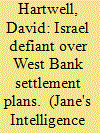

|
|
|
| 10 |
ID:
142438
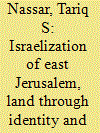

|
|
|
|
|
| Summary/Abstract |
After Israel occupied the West Bank following the 1967 War, it annexed around 70.5 square kilometers of the West Bank into the Jerusalem municipality boundary and claimed Jerusalem as an open city. The Palestinians who remained in Jerusalem were protected by the International Humanitarian Law (IHL), since the annexation conflicted with the resolutions of the United Nations Security Council (OCHA, 2009). The Israeli government at that time granted the Palestinian Jerusalemites a permanent residency status and offered them the right to apply for Israeli citizenship, but Palestinians refused to apply for it (Barakat, 2012). In order to understand the issues surrounding Jerusalem, we must place the urban planners of the city at the forefront of suggestions and strategies based on their visions through working with the hegemonic power of the land (Yiftachel, 2006).
|
|
|
|
|
|
|
|
|
|
|
|
|
|
|
|
| 11 |
ID:
108905
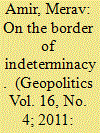

|
|
|
|
|
| Publication |
2011.
|
| Summary/Abstract |
Drawing on a perspective which takes into account the convergences of sovereign and biopolitical ruling apparatuses, the aim of this article is to provide a comprehensive view of the Separation Wall constructed by Israel in East Jerusalem, and, through it, of Israeli control of Palestinian East Jerusalem. Neither a comprehensive border, nor a mere barrier, the Separation Wall which is being constructed in Jerusalem operates to reinstates sovereign power in arrays of governmentality for the purpose of drawing on the ability of sovereignty to appropriate legitimacy for the territorialisation of governmentality. This article claims that these territorialised arrays of governmentality give rise to processes of racialisation, by maintaining a grip on the communities of Palestinians in East Jerusalem and sustaining them in an intermediate position, standing in the way of their full integration into the Israeli population while severing their existing connections with the Palestinians in the West Bank.
|
|
|
|
|
|
|
|
|
|
|
|
|
|
|
|
| 12 |
ID:
167960
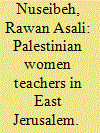

|
|
|
|
|
| Summary/Abstract |
This article focuses on the multiple layers of structural discrimination that Palestinian women face in finding employment in occupied East Jerusalem. Faced with limited opportunities in a stagnant economy, isolated from the rest of the Palestinian periphery, and not fully integrated into Israeli society, they are often more educated than their male peers, but family considerations and gender norms shape their educational and professional decision-making processes, trapping them in "feminized" professions such as teaching. As a result, Palestinian women in East Jerusalem have some of the lowest levels of labor participation, regionally and globally.
|
|
|
|
|
|
|
|
|
|
|
|
|
|
|
|
| 13 |
ID:
123891
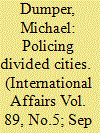

|
|
|
|
|
| Publication |
2013.
|
| Summary/Abstract |
The study of conflict in cities has emerged as a significant subfield in a number of disciplines. For policy-makers and analysts concerned with humanitarian interventions in cities emerging from conflict, the city as a form of human organization and its impact upon the establishment of security is of particular importance.
Less academic attention has been given to divided cities where the legitimacy of the state authority controlling the city is, itself, in question and where stabilization and the establishment of security is protracted. The adoption of integrative and inclusive approaches to policing becomes a key component in security regimes in divided cities. In these cases, however, to what extent should the stabilization phase be recast? Is the law enforcement phase subsumed and over-ridden by national security concerns?
This article examines these questions by suggesting a number of security models which have been used in a range of divided cities. It focuses in more detail on a study of Israeli policing in the Palestinian areas of East Jerusalem occupied by Israel after 1967 to draw some broader conclusions about the nature of the security regime in Jerusalem and other divided cities inside contested states.
|
|
|
|
|
|
|
|
|
|
|
|
|
|
|
|
| 14 |
ID:
186983
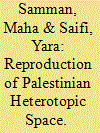

|
|
|
|
|
| Summary/Abstract |
This article was written during the first wave of the COVID-19 pandemic in East Jerusalem between March and June 2020. It discusses how the Palestinians approached the pandemic within the context of occupation, and how they used their power to reproduce what Henri Lefebvre called heterotopic spaces. People articulated these spaces accumulatively as they sought meaning in their daily lives, while managing the pandemic and benefitting from their previous experiences during their struggle against Israeli occupation. Thus, the aim is to shed light on the evolving role of civil society to support local action in dealing with a pandemic and to understand COVID-19 from peoples’ perspective rather than from a top-bottom lens in occupied cities. The methodology is multilayered: We use theoretical concepts of heterotopic spaces and analyze them through the social/societal, the temporal/historical, and the spatial/geographical forms of knowledge borrowed from Michel Foucault, Henri Lefebvre, and Edward Soja. It also builds on participant observation, official and media sources, and semi-structured interviews conducted with heads of committees of the Jerusalem Cluster community initiative. Accordingly, the study illustrates how the voices of the people become more significant in taking a leading role in a pandemic crisis in an occupied city.
|
|
|
|
|
|
|
|
|
|
|
|
|
|
|
|
| 15 |
ID:
177981
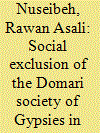

|
|
|
|
|
| Summary/Abstract |
This study looks into the lives of women from the Domari Society of Gypsies in Jerusalem. Residing in a conflict-ridden city and exposed to multiple stigmas, the study exposes the structures that perpetuate the disempowerment of Domari women in Jerusalem. It looks into their neighbourhoods, the social services available to them, the education services that they receive, their opportunities in the labour market, and the marriage patterns in the society. The study adopted qualitative research methods to allow the research participants to narrate their stories in ways meaningful to them. The narratives were analysed through an intersectional lens to expose the multiple oppressions these women are subject to. The women’s stories reveal high levels of stigma and isolation, which have disempowered members of the community and perpetuated the cycle of their exclusion.
|
|
|
|
|
|
|
|
|
|
|
|
|
|
|
|
| 16 |
ID:
111644
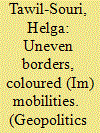

|
|
|
|
|
| Publication |
2012.
|
| Summary/Abstract |
The Israeli state apparatus mandates differentiated IDs to Palestinian citizens of Israel, Palestinian non-citizens in East Jerusalem, Palestinians in the West Bank and Gaza. The bureaucracy of Palestinian ID cards since 1948 has rendered Palestinians more legible for the security interests of Israel while simultaneously discriminating Palestinians from Jews as unequal citizens and non-citizens. The ID card regime, and less so the permit regime, limits Palestinian geographic movement and economic mobility while simultaneously permitting freer Jewish-Israeli flows and mobilities. ID cards demonstrate the power of the Israeli regime to produce distinct people and bind them to specific territories (such as the Palestinians), while allowing others (Jewish-Israelis) to 'trespass' over those same boundaries. Through ID cards borders are erected between Jewish and Arab people, not Israeli and Palestinian territory. The ID card regime puts into question the nature and territorial boundaries of 'Israel', and the geopolitical existence of the 'Palestinian Territories.
|
|
|
|
|
|
|
|
|
|
|
|
|
|
|
|
| 17 |
ID:
175778
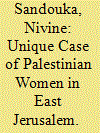

|
|
|
|
|
| Summary/Abstract |
As a Palestinian woman living in East Jerusalem, I often find myself with the same group of women when participating in activities related to peacebuilding and Track II negotiations. I often ask myself, why it is that in one of the most contested cities in the world, those who are most affected by the political realities are also the most marginalized and least represented. I refer, not only to the more than 350,000 Palestinian residents of East Jerusalem but rather, more specifically, to the women who make up almost 50% of that number.
|
|
|
|
|
|
|
|
|
|
|
|
|
|
|
|
| 18 |
ID:
190975
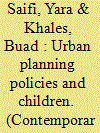

|
|
|
|
|
| Summary/Abstract |
This article undertakes a physical assessment of the outdoor environment of Israeli-administered kindergartens in East Jerusalem. It investigates their suitability to accommodate the proper development and growth of the Palestinian children who use them. Due to Israeli-imposed policies and laws and the lack of proper urban planning, scope for Palestinian growth and expansion in East Jerusalem is limited. This has resulted in a shortage of spaces, poor living conditions, and a lack of adequate facilities, including kindergartens. This assessment of 47 kindergartens’ outdoor environments, along with interviews with 9 teachers, shows that the spaces allocated for children in kindergarten playgrounds are small and do not meet the standards required to allow free play. Although the kindergartens studied are administered and licensed by Israeli laws and standards, the results show that the conditions in them do not provide safety, privacy, diverse types of play equipment, and the natural surroundings important for an outdoor play environment conducive to children’s development and learning.
|
|
|
|
|
|
|
|
|
|
|
|
|
|
|
|
| 19 |
ID:
142447
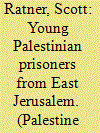

|
|
|
|
|
| Summary/Abstract |
The more youth become actively involved in confronting the occupation, the more prison will remain a persistent feature of Palestinian society in Jerusalem.
|
|
|
|
|
|
|
|
|
|
|
|
|
|
|
|
|
|
|
|
|